Tillandsia cacticola
Click thumbnails for full size, scaled to a new window.
Tillandsia cacticola
Species, Peru.
See also T. 'Splendid' page for discussion of cacticola var. splendida, Splendid, Splendide, caulescent and succulent forms.
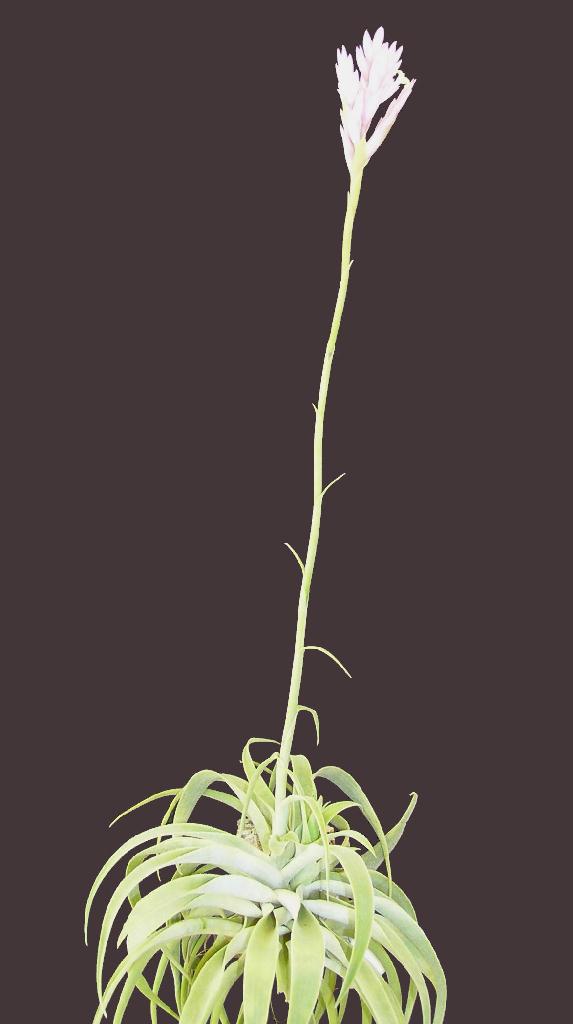
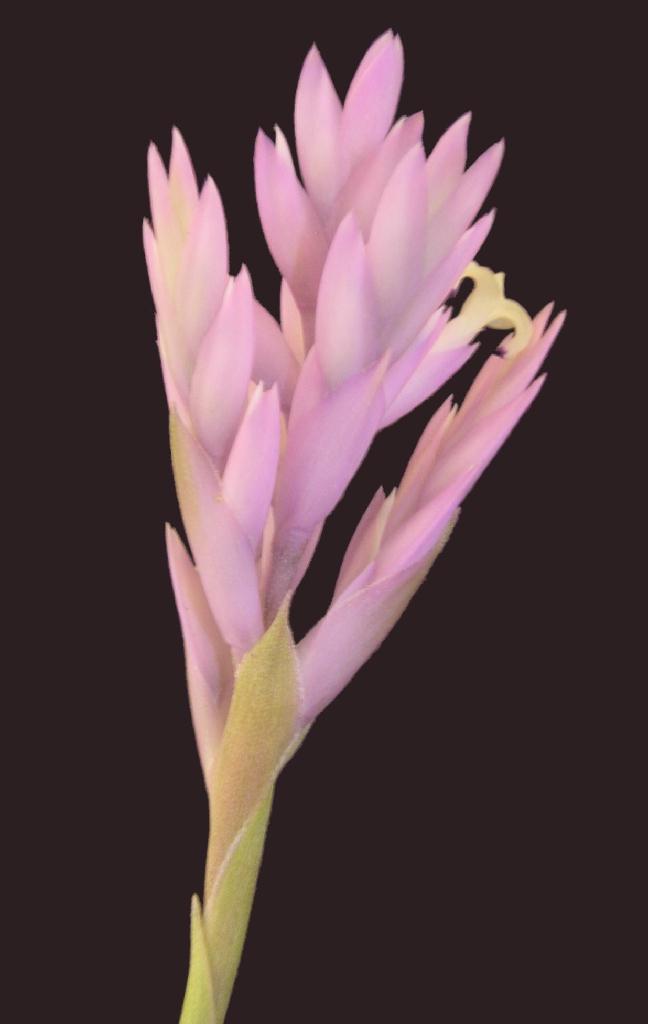
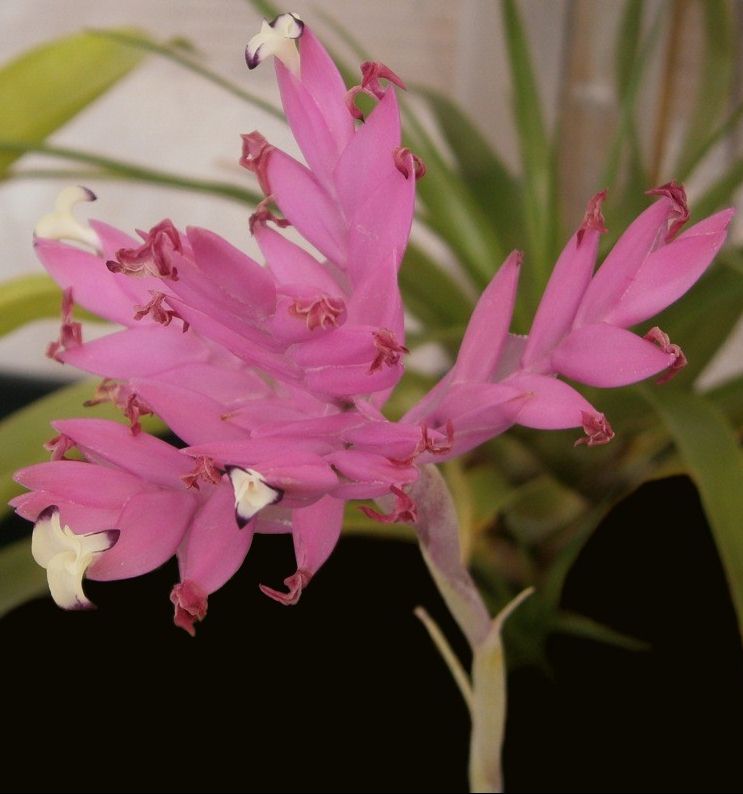
| Ken Woods 08/10. |
Ray Clark 08/13. |
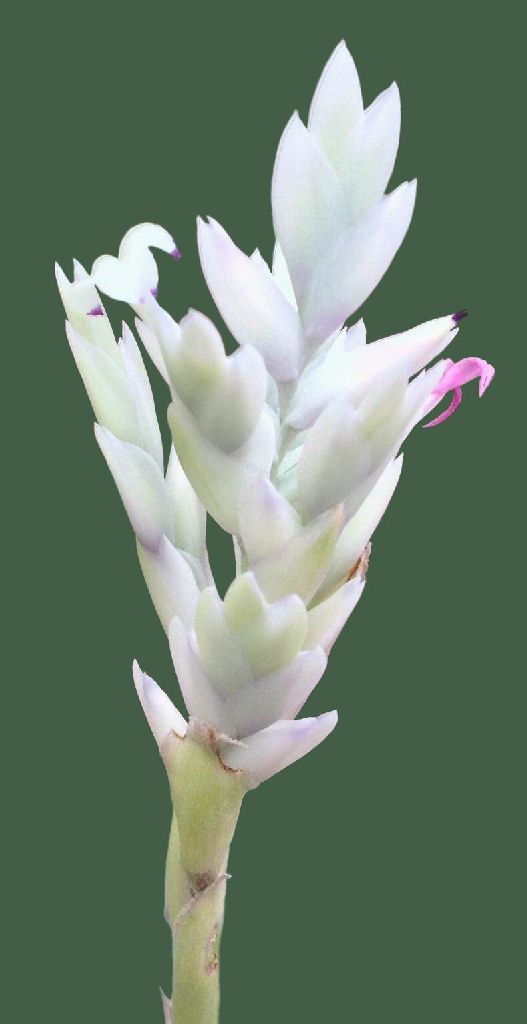
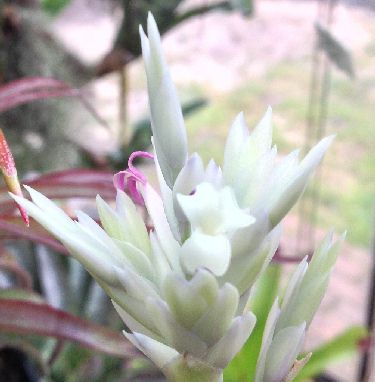
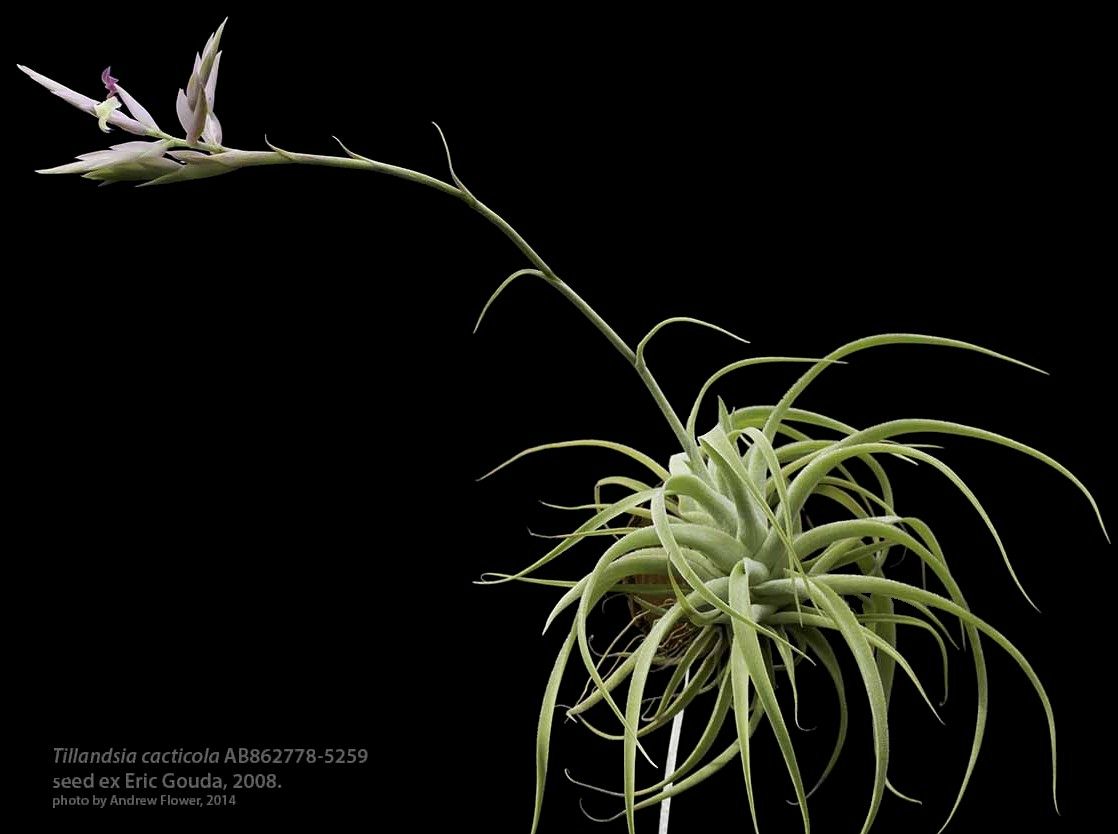
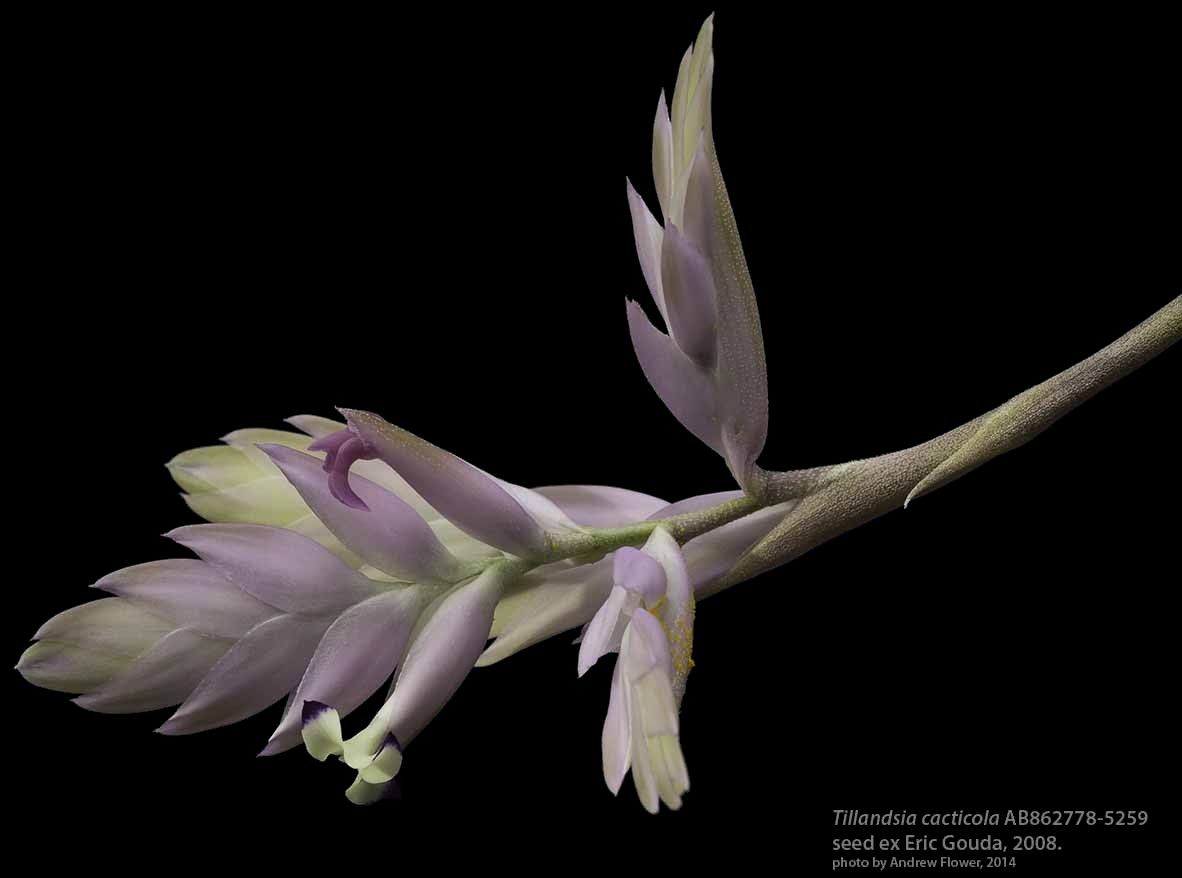
| Stephen Morgan 09/14 |
Andrew Flower 08/13 ex. Eric Gouda |
Stephen Morgan ... "Bought as cacticola, but thin purple edge on petals ??"
Andrew Flower ... "Your plant looks much like one I have flowering here at present - grown from seed Eric Gouda sent me in September 2008 (according to my computer his label said cacticola number 143, or maybe that was his seedbank number).
Mine is quite a small plant: 8cm diameter, 32cm tall of which the inflorescence contributes 28cm. Spikes 5cm, flower 13mm dia, no scent discernable by a male nose.. See purple edge on petals."
Eric Gouda ... "Yes, it was the seed bank number, it was seed from my collection in 2008 and I can look into it if I have any data on it.
I have several wild clones and have to cross them to get seeds I suppose. It looks like a quite normal T. cacticola to me."
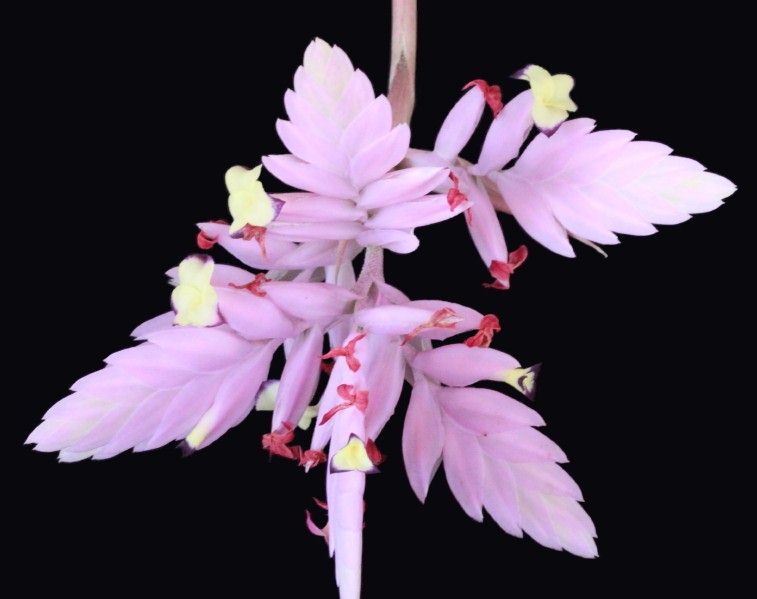
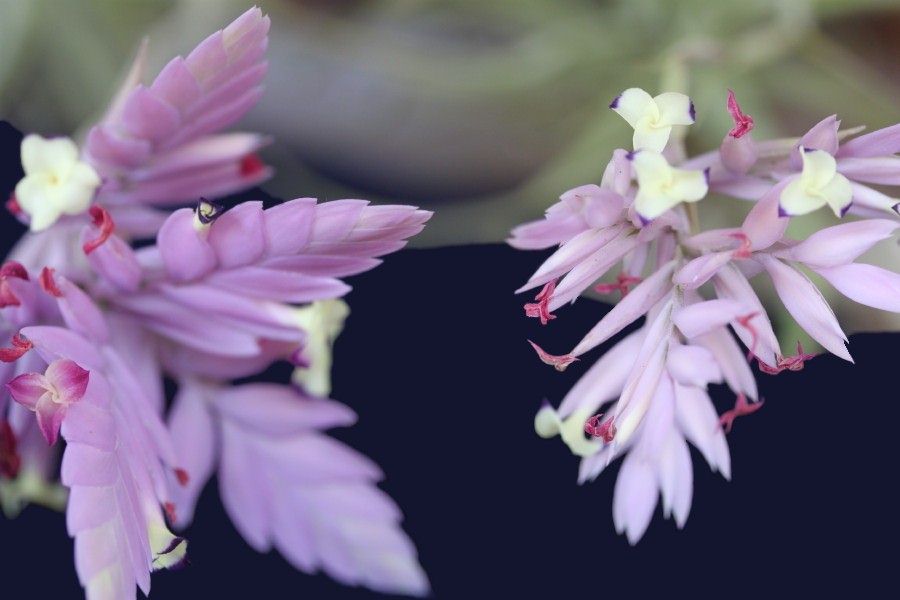
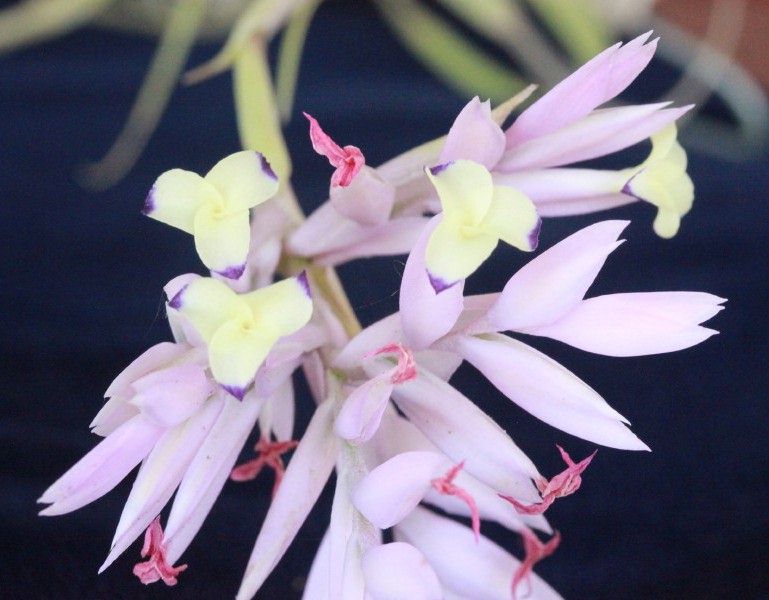
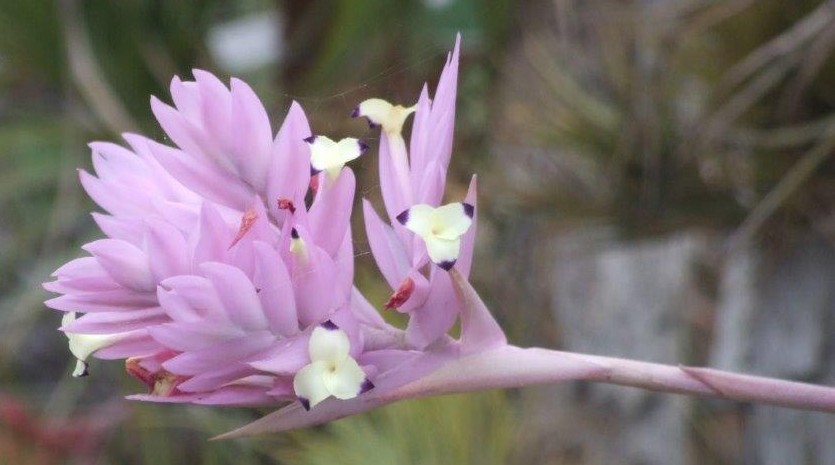
| Pam Buttler 10/14. "I have two T. cacticola flowering at present.One I bought in Melb. and the other imported.The imported one is the much bigger plant and bract." |
Rob Bower 10/17 |
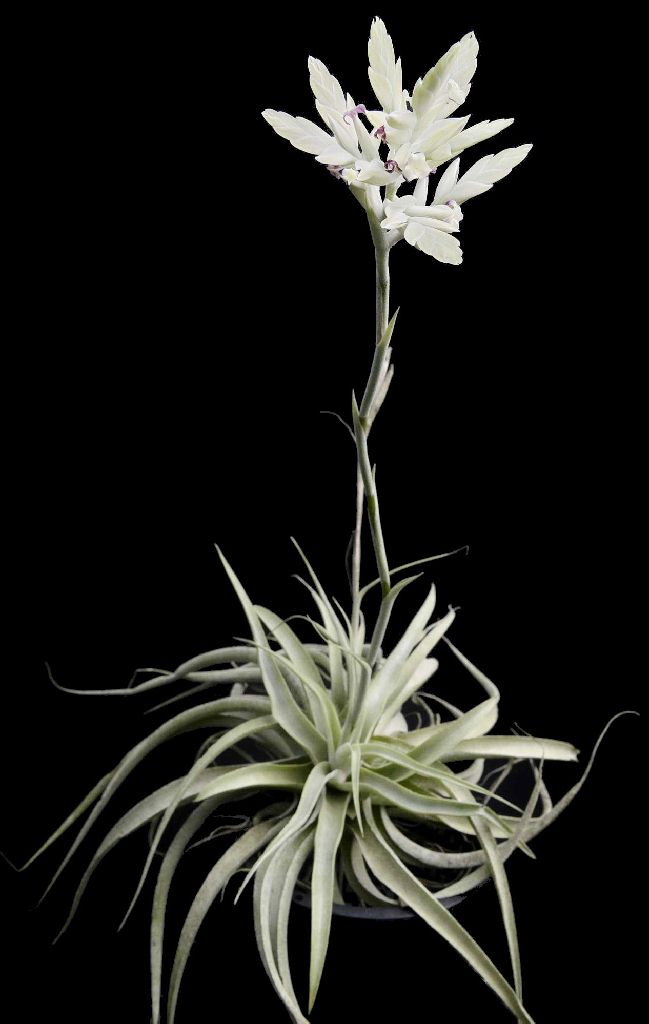
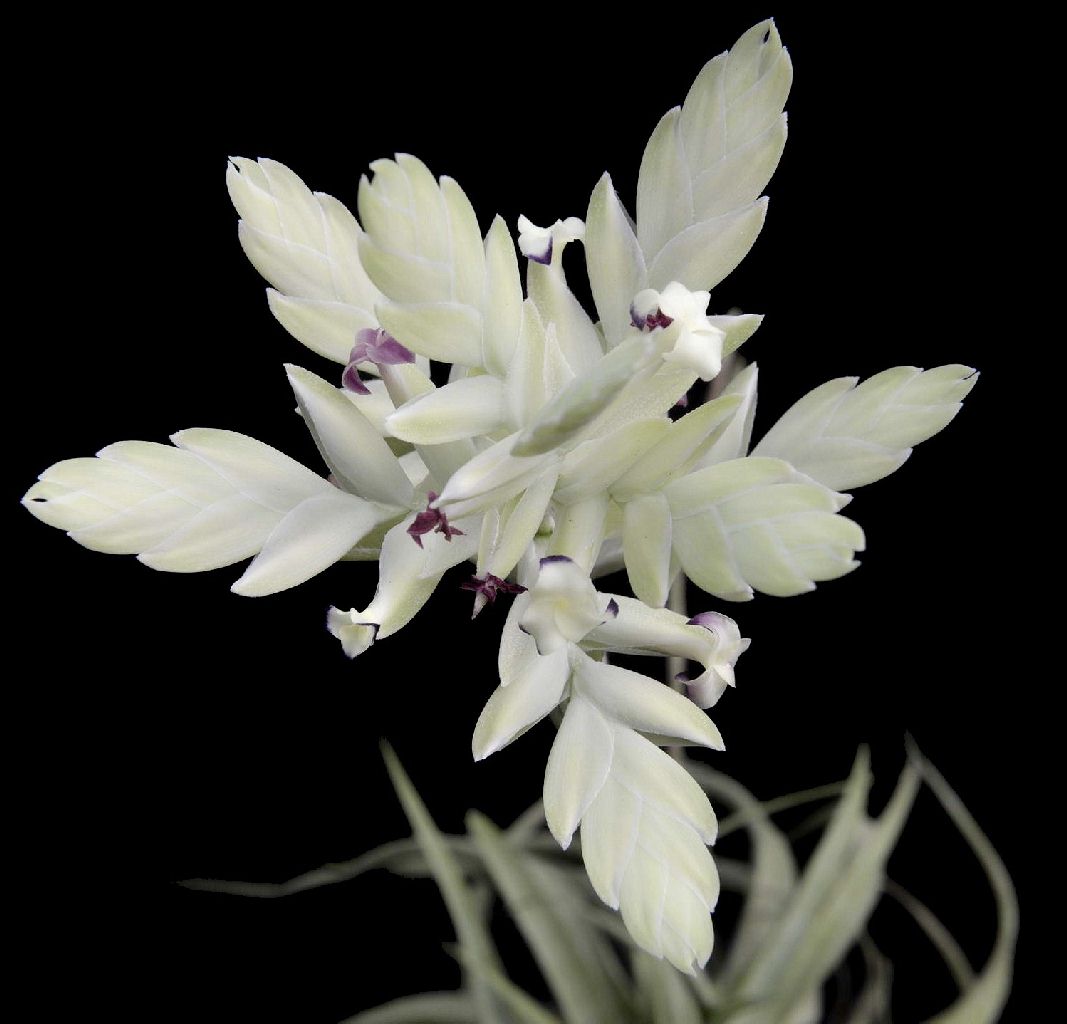
| Peter Tristram 11/18. All white bracts. |
Peter Tristram ... "I was recently surprised to find a white-bracted cacticola among the Franz Gruber plants imported after Chris, Michael and I travelled to Colombia in 2014. So far the rest have bloomed the usual bright pink. The first blooming of this form ended abruptly when an animal of some type munched off the spike so I was unaware of its lack of pink pigment. Someone has a pup from it as I assumed it was a pink one like the others. Chris and Michael need to keep an eye on theirs too. The white isnít as pure as T. Casper so Iíll dream up a cultivar name for it. Thereís a yellow flowered, white bracted form too at Franz's Nursery."
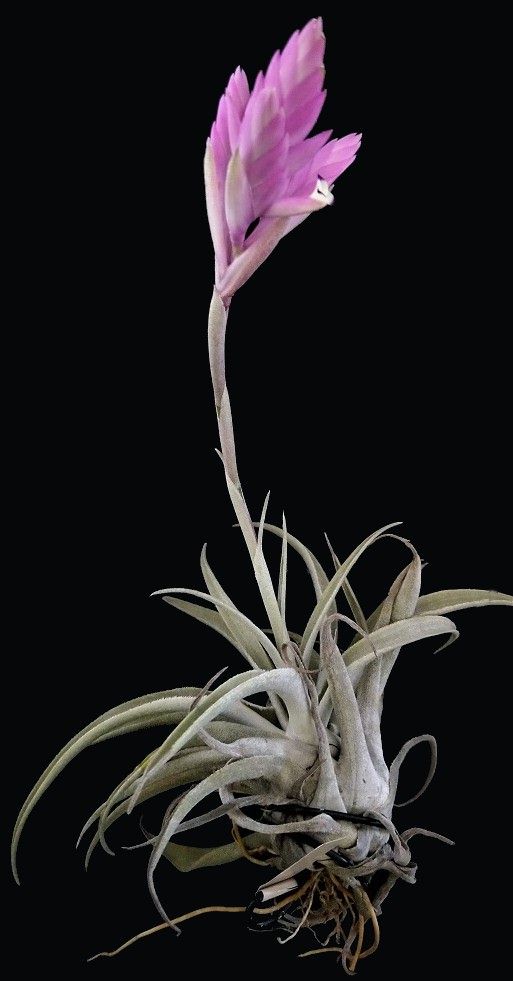
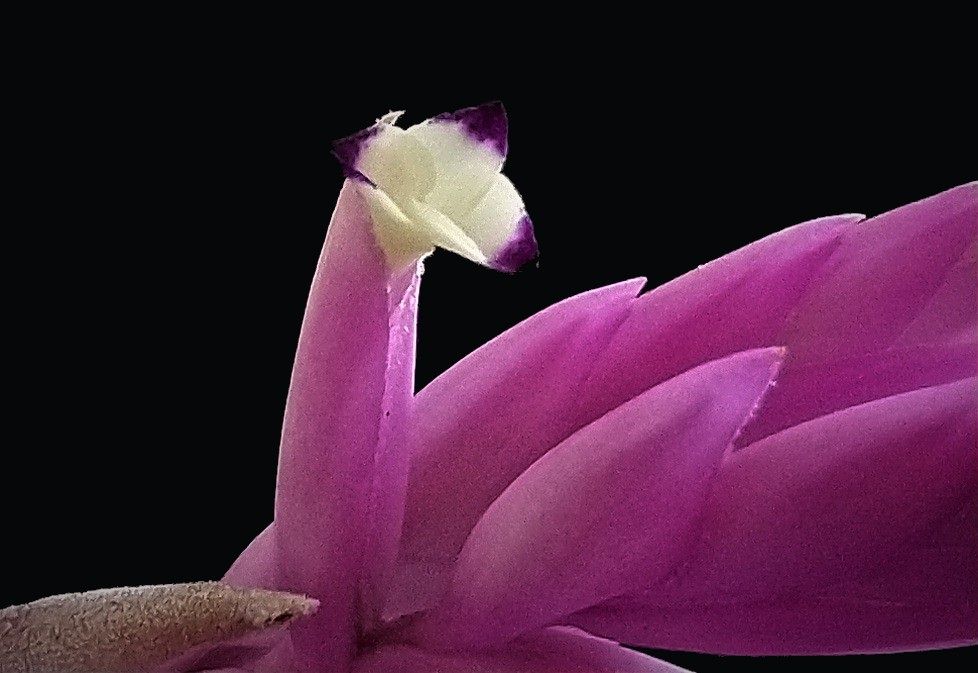
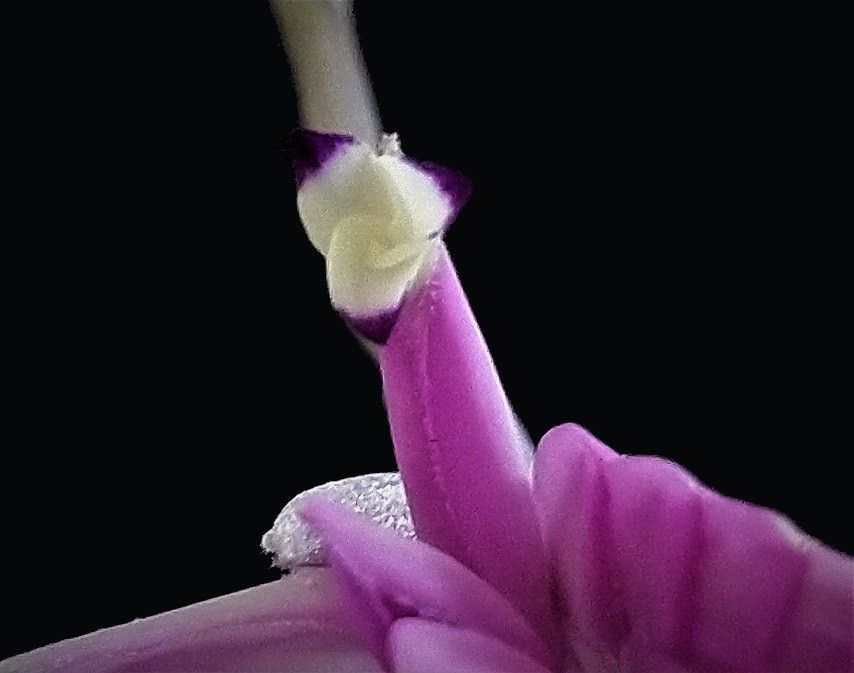 Steve Molnar ... "a great show before the main event. I really like the colour of the inflorescence, and it colours up well in advance of the flowers. The first flower has just come out and looking forward to more of them emerging."
Steve Molnar ... "a great show before the main event. I really like the colour of the inflorescence, and it colours up well in advance of the flowers. The first flower has just come out and looking forward to more of them emerging."
Chris Larson ... "Iím not sure if we were the only importers of this sort of T. cacticola, but we imported it back in the 90s (I think) & sold it as T. cacticola compact form Ė I think we got a couple of 100 of them. It is on the disc Ė but not a well grow specimen."
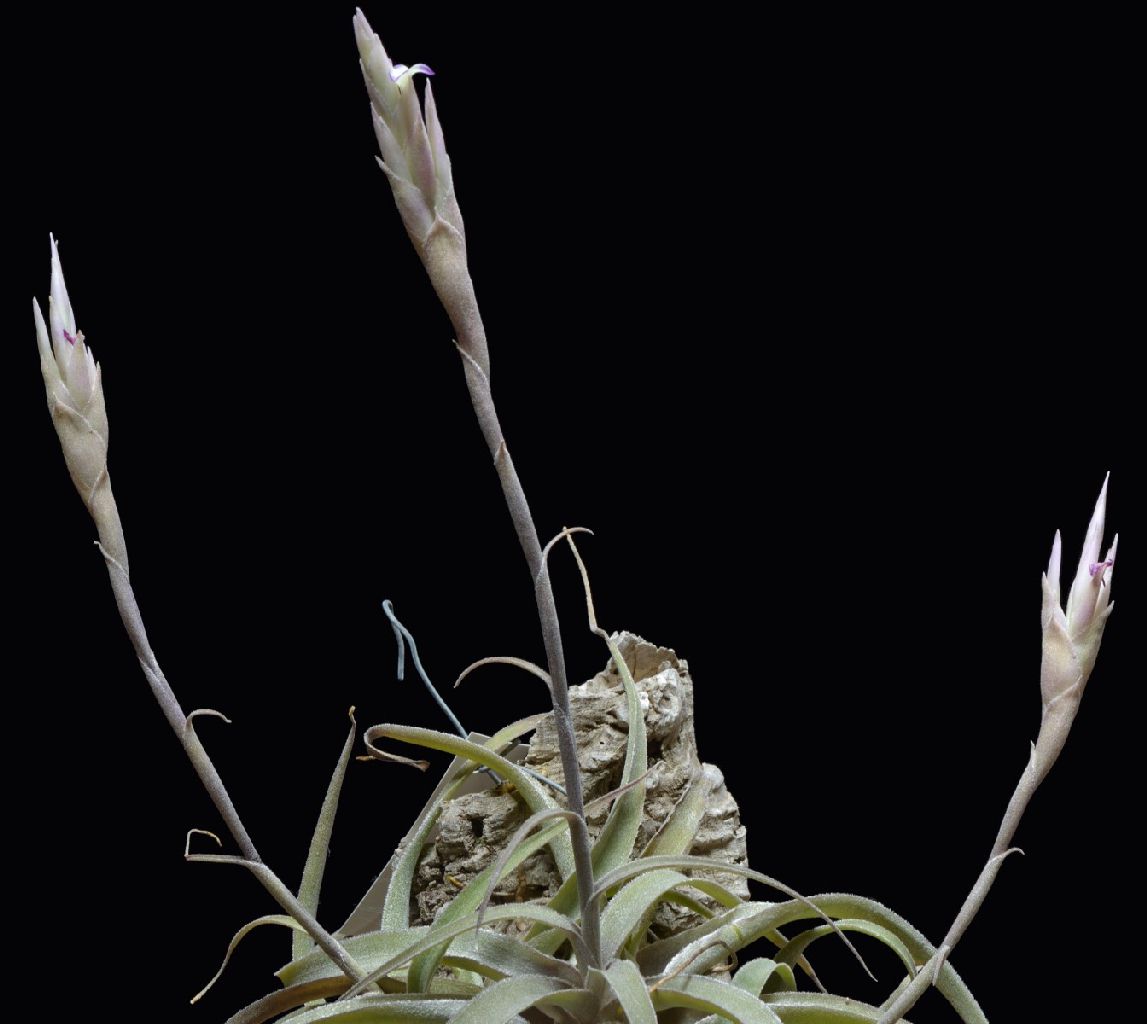
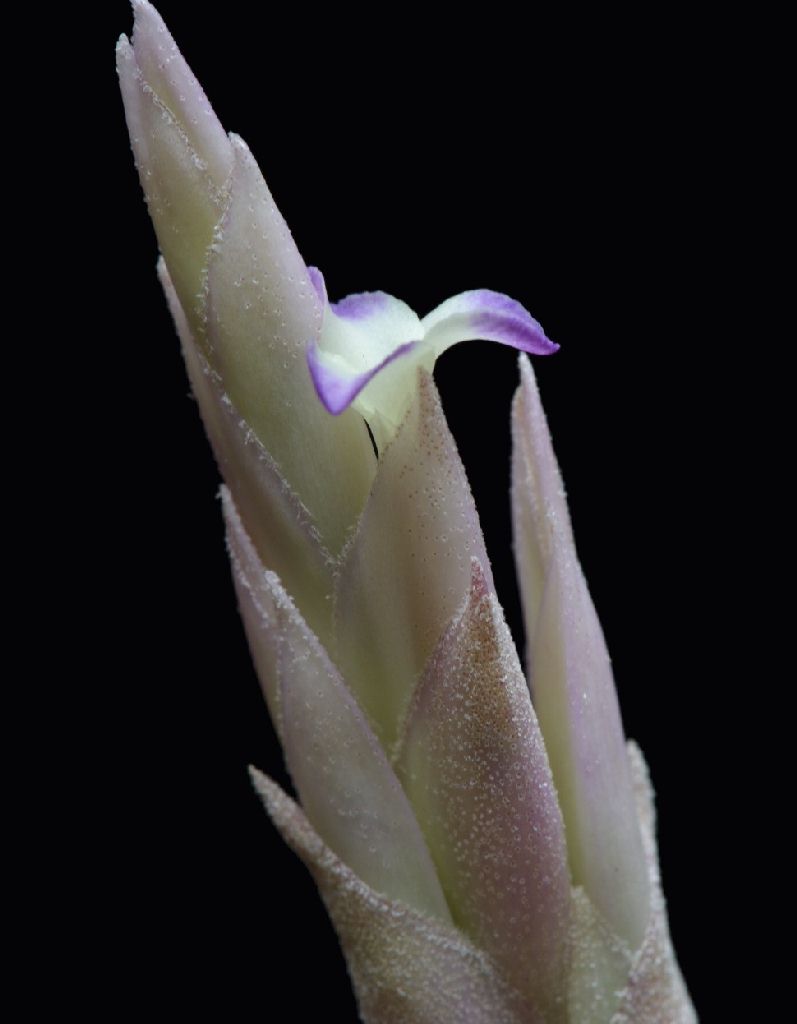
| George Nieuwenhoven 01/20 |
George Nieuwenhoven ... "This T. cacticola looks rather different than the one I am used to. It was imported not by me from Holm. Perhaps someone can explain why it looks so different, it could almost be mistaken for a hybrid."
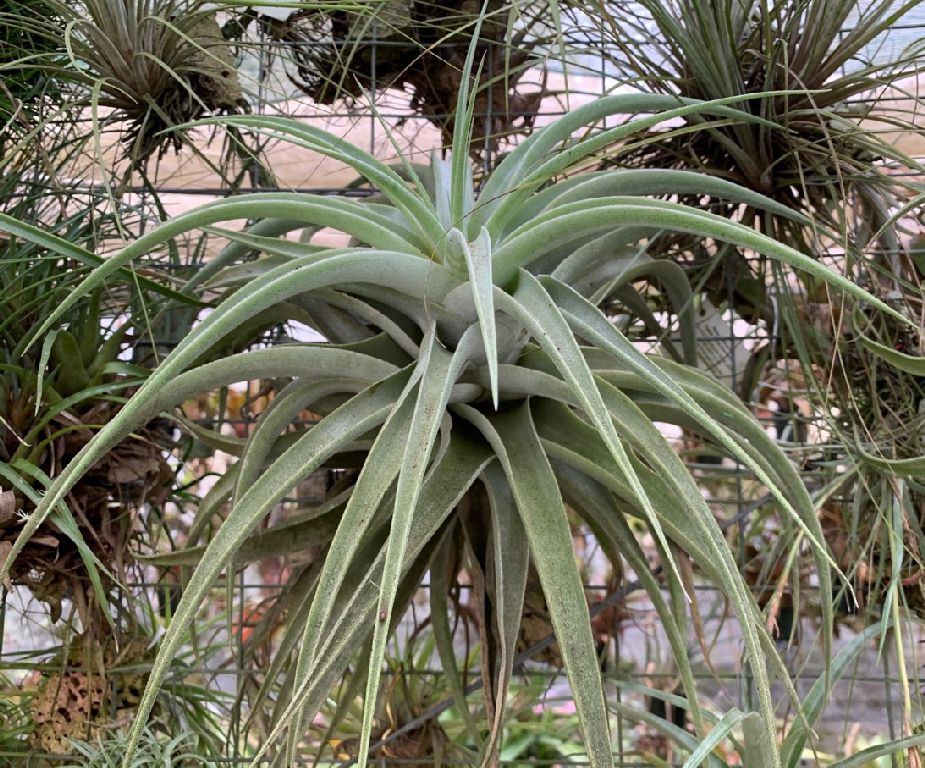
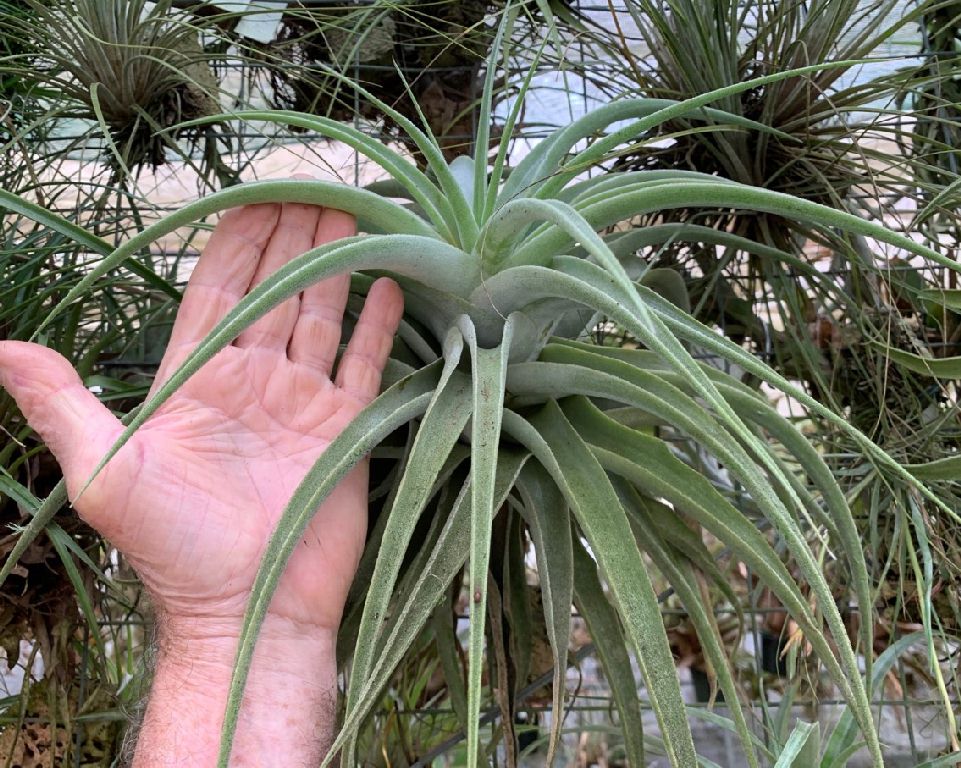 Peter Tristram ... "So many of the wonderful Tills and relos come in so many variations. If you say you have a certain species, expect to be asked, ĎWhich form?í. For years, Peruvian species were distributed by Karel Knize. Unfortunately the dreaded gas killed most but at least a few of this fine form of T. cacticola survived. Itís huge and succulent, this baby grown under shadecloth, but yet to bloom. Dare I say that itís a dead ringer, foliage wise, for Harry Lutharís var. splendida, now not recognised, though not all of us are in agreement there."
Peter Tristram ... "So many of the wonderful Tills and relos come in so many variations. If you say you have a certain species, expect to be asked, ĎWhich form?í. For years, Peruvian species were distributed by Karel Knize. Unfortunately the dreaded gas killed most but at least a few of this fine form of T. cacticola survived. Itís huge and succulent, this baby grown under shadecloth, but yet to bloom. Dare I say that itís a dead ringer, foliage wise, for Harry Lutharís var. splendida, now not recognised, though not all of us are in agreement there."
Alfonso Trudu ... "So this plant will be different from T. Splendide ex Paul Isley which I bought from Chris Larson? Maybe yours from Karel Knize is bigger."
Chris Larson ... "Hi Alphonso
I have 2 forms of the T. cacticola Splendide
1. An old import, and I have no idea where it came from - though likely Peter Tristram, probably more than 30 years ago.
2. An import from Guatemala 10 or 15 years ago.
3. I have never had a T. cacticola Splendide that I know has provenance leading to Paul Isley.
They both look the same as Paul Isley's form but I have not seen them bloom.
I have recently put them at work under "pumped conditions" but I am still waiting - they are now huge.
The T. cacticola Splendide is caulescent. Pedros is not. (I also have semi caulescent forms.)
There are just so many forms of cacticola around. Not sure the BCR expands that far. Even amongst what I have as the T. cacticola Chunky's - there are smaller and larger forms - and quite different in size. I am not sure that naming everything is the answer to issues. I don't believe pidgeon holes for all creates a desirable outcome.
Just look at ionantha. Squillions of names - then someone thinks it looks like the photo on the net - and sticks that name on. Over the past few years, while looking around the collections in SE Qld I found soooo many wrong names on ionantha where I am confident that I understand the cultivar to think I know what they should be. And so many more on where I was not so confident I understand the cultivar.
This - "we have enough names out there - see one that has a photo at one period of growth where it looks similar - then whack a name on it". Then the seasons change, the looks of the growth changes - and voila we have a different plant with the same name, being propagated and masquerading as the wrong plant. The names are then pointless.
Alternately, T. ionantha var stricta, being a scientific taxa - and we have people saying that their T. ionantha var stricta is not that as it is different to their other T. ionantha var stricta - so it is not stricta. A specific variety from a particular area will all be different - and have the same name where the taxonomists decide so.
Then we have the description of T. ionantha var stricta stating that it is not the plants being collected and sold in Guatemala (Pam's article states quite clearly that T. ionantha var stricta comes only from a region of Mexico - and is different to those in Guatemala). One of the plants in Guatemala falls closely (but so obviously different) to the description of T. ionantha var stricta - and we now have these Guatemalan plants being diagnosed erroneously as T. ionantha var stricta. This is even stated where a banded form of the Guatemalan T. ionantha (similar to var stricta) that used to be called T. ionantha var zebrina is now on Taxon as being a form of T. ionantha var stricta - contrary to the analysis by Pam Koide in the BSI article describing T. ionantha var stricta."
Peter Tristram ... "Thereís a subtle difference between splendida and splendide! One is a Latin term so can be used in taxonomic descriptions, the other French or Italian. Somewhere in my photos of plants Iíd have pics of the Selby variety splendida which was never published it seems. In fact I think I might use 'Chunky' and forget all about the Selby form... though RFI has the same chunky form sold as splendida too! I got one from Paul Isleyas did Bob Hudson. I wonít even start to think about ionantha!"
Chris Larson ... "Peter: Does T. cacticola var splendida have any relevance to Bird Rock Tropicals' T. cacticola Splendid ?"
Peter Tristram ... "Hi Chris: interesting thought. Did we get it from Pam? Or did Bob get the plant I mentioned from BRT?"
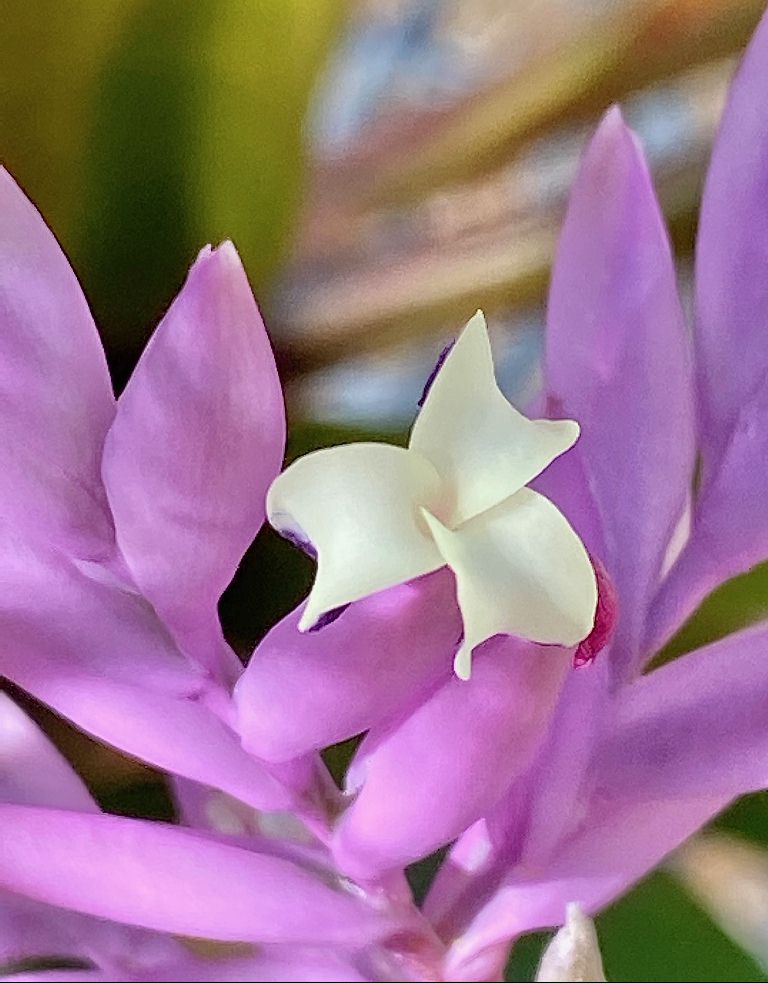
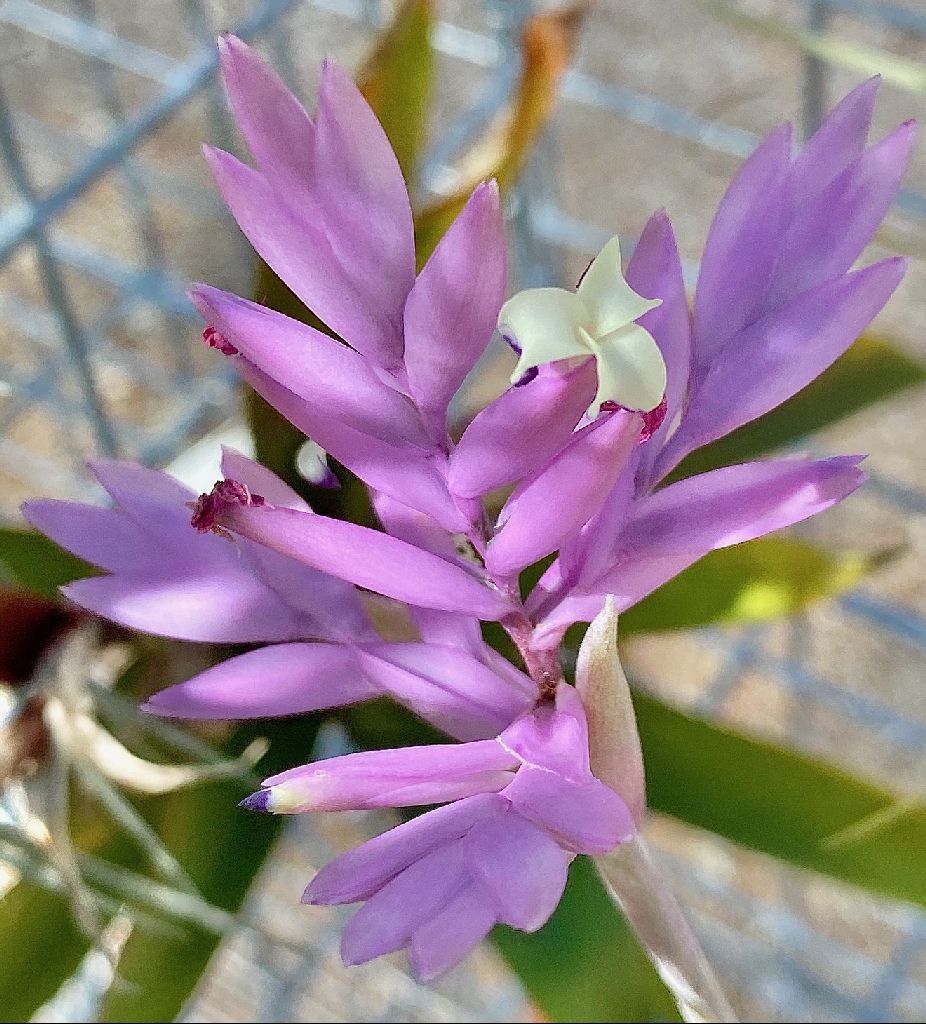
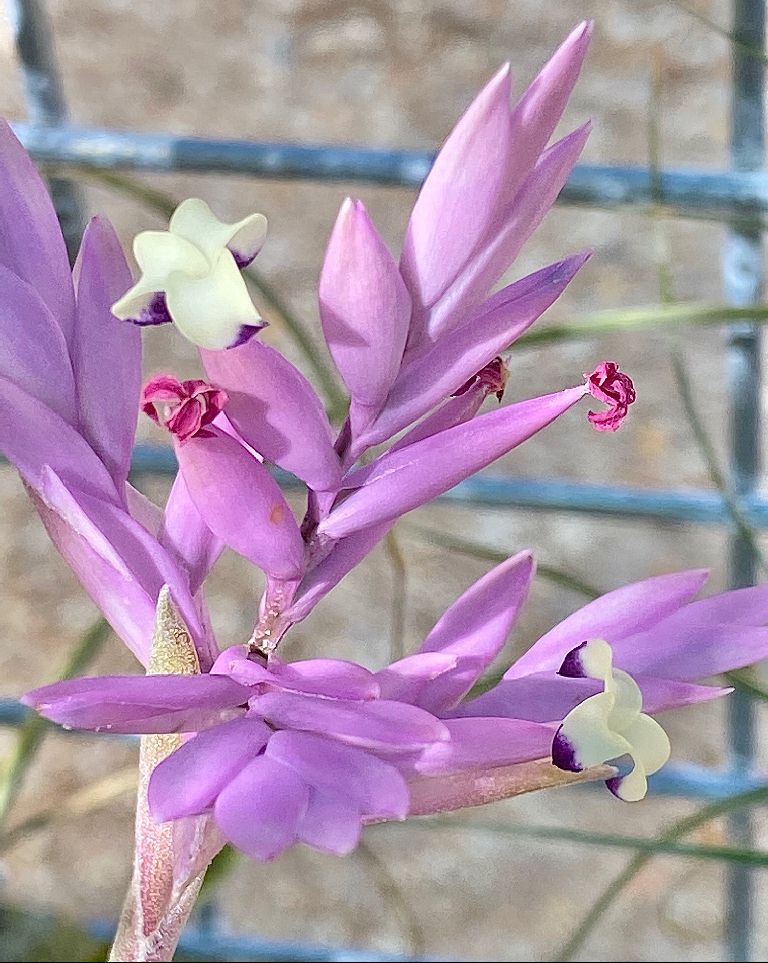

| Dale Dixon 08/20 Ex. Margaret Paterson |
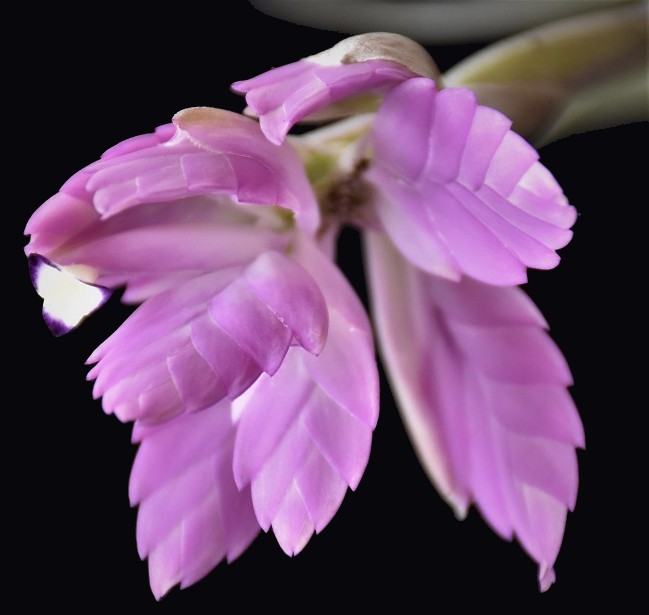
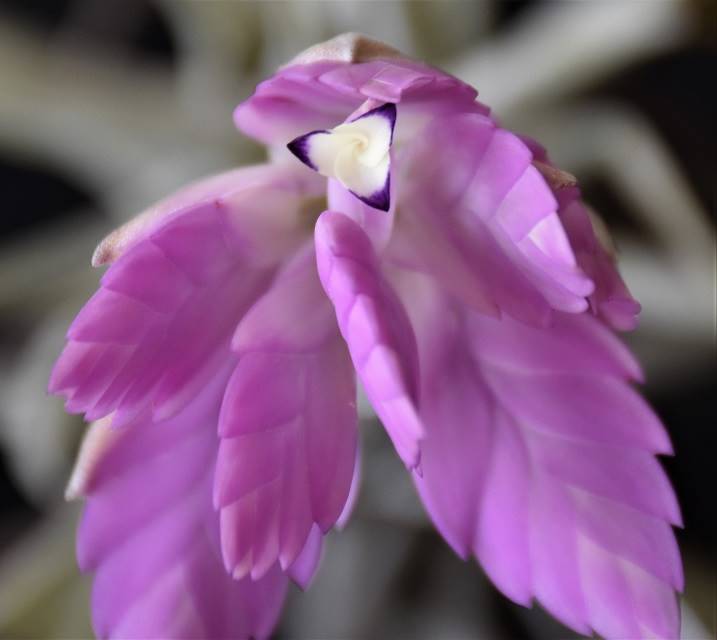
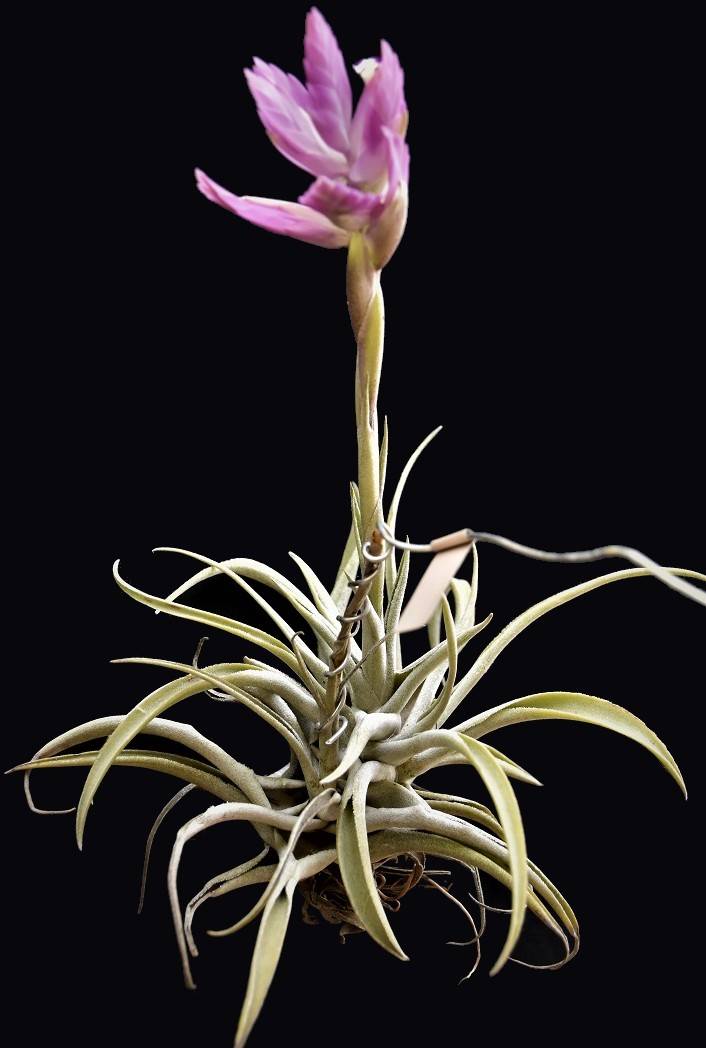
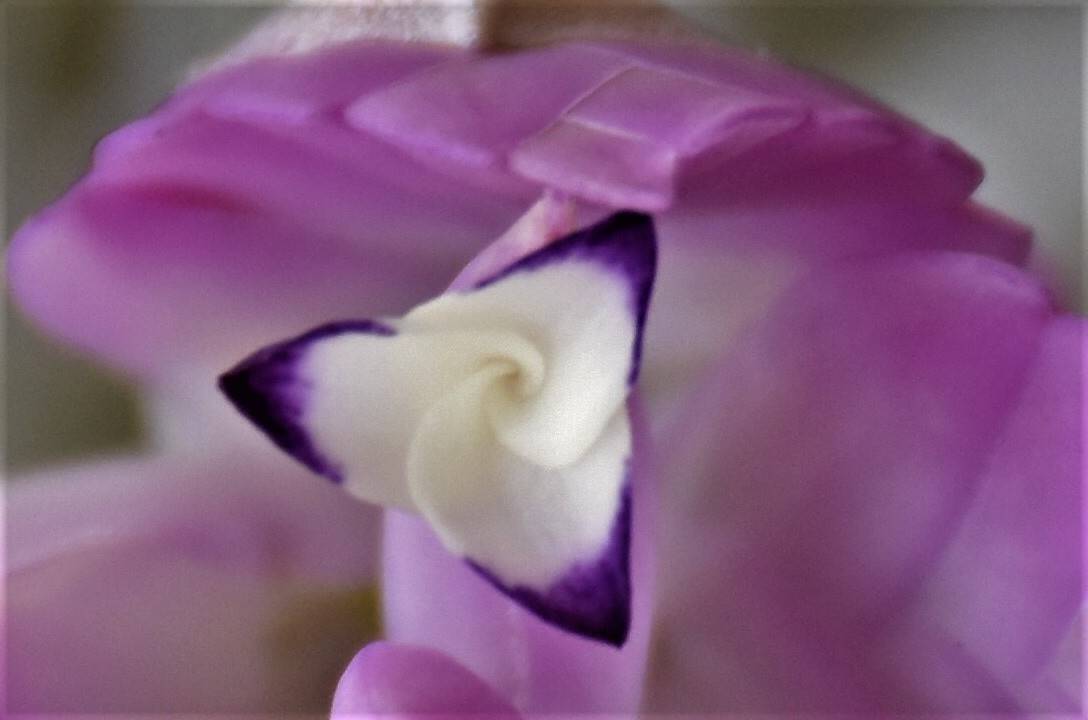 Steve Molnar ... "Quite a compact form this one, a real favourite in my collection. Will be looking out for the other forms."
Steve Molnar ... "Quite a compact form this one, a real favourite in my collection. Will be looking out for the other forms."
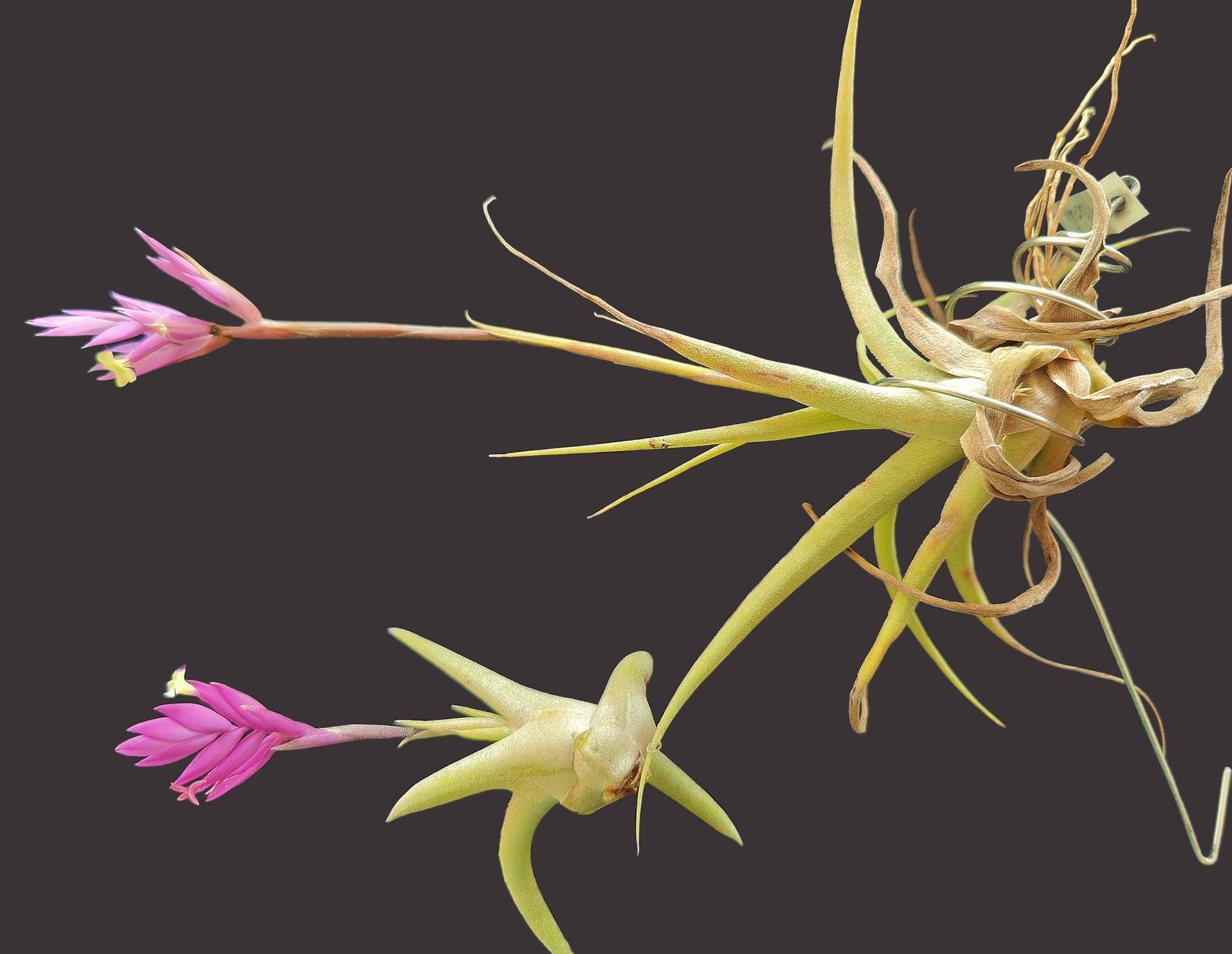
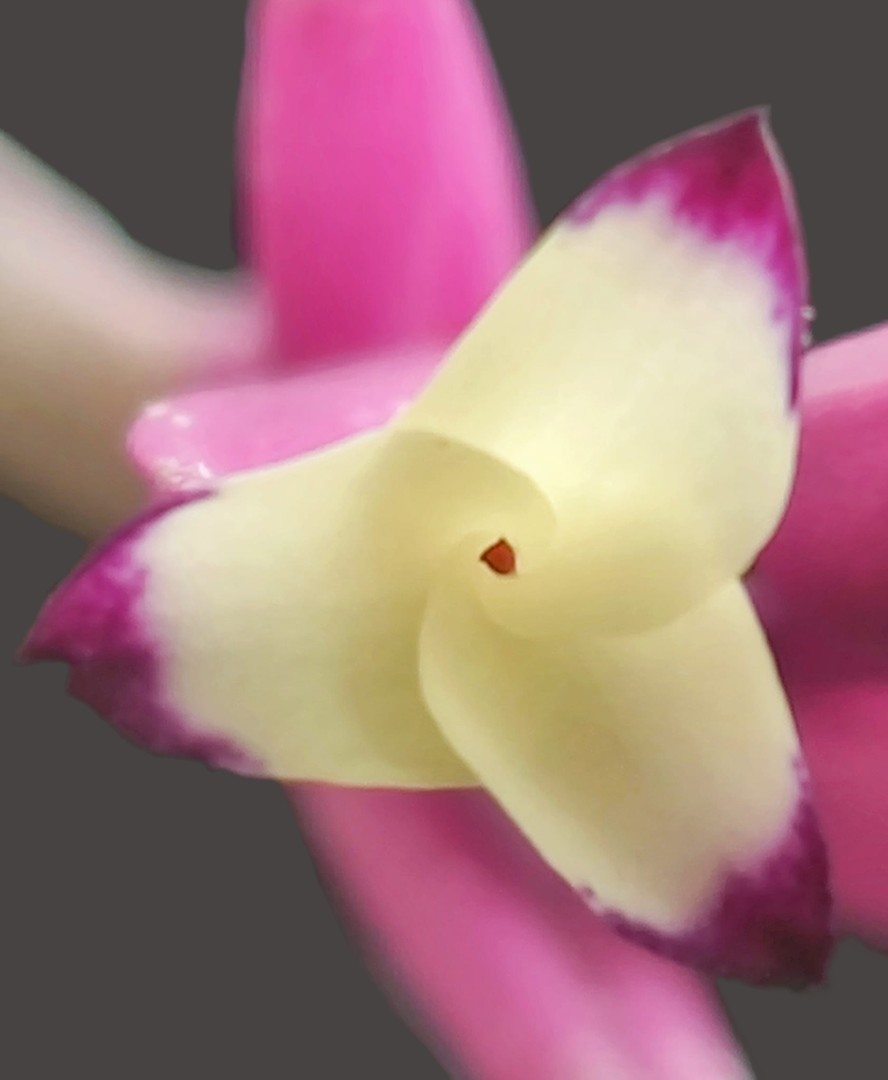
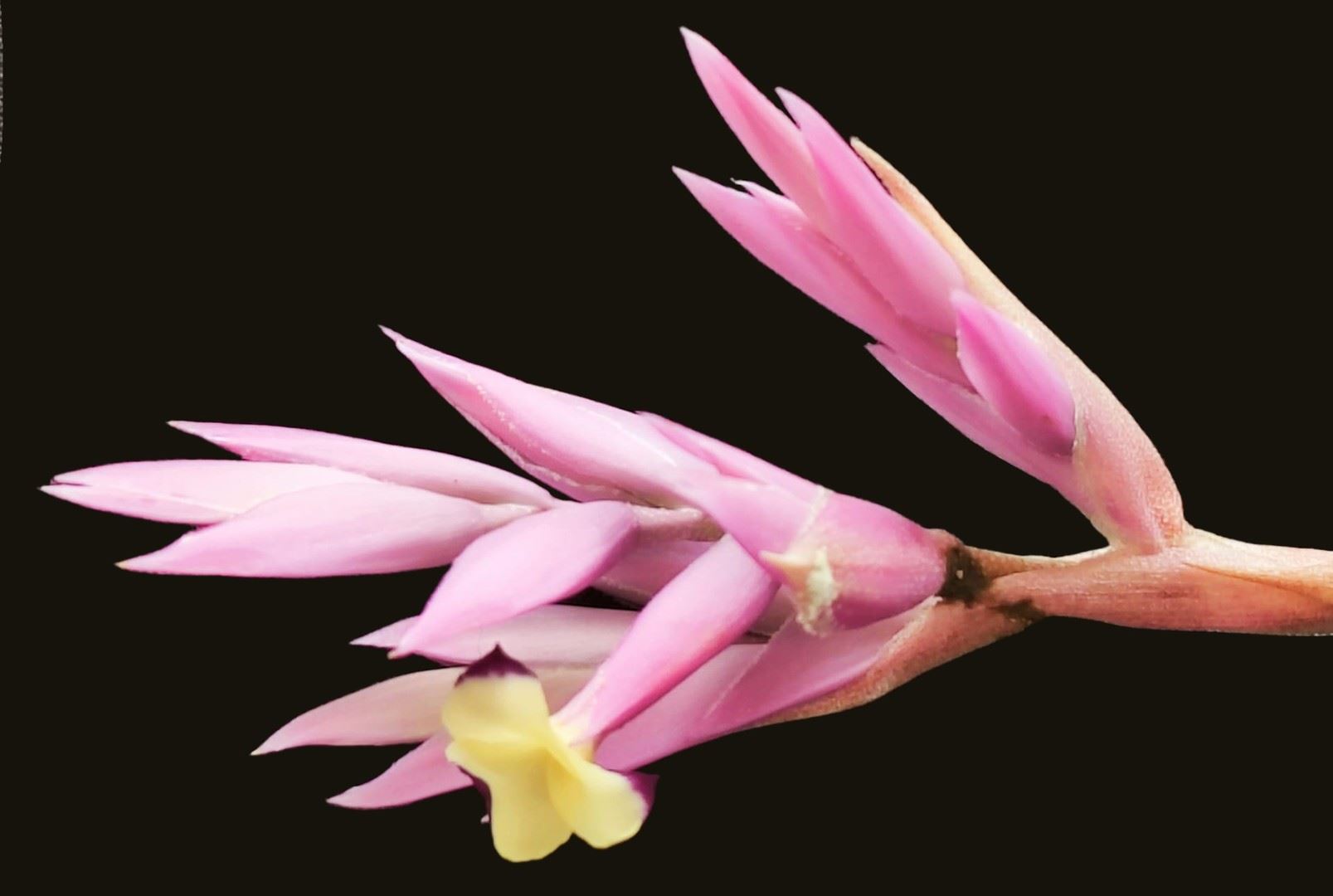
| Steven Molnar 08/22 "Two forms" |
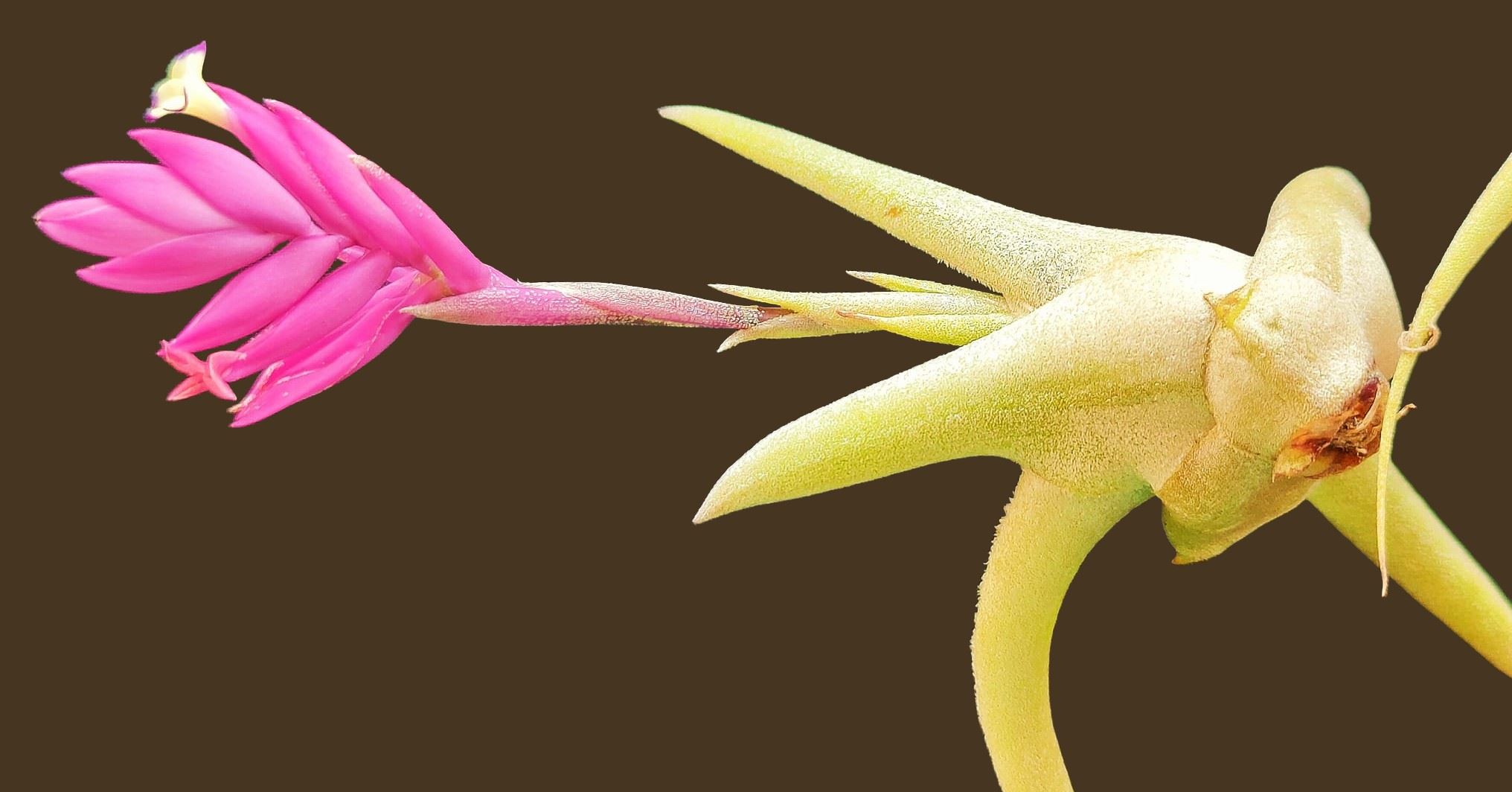
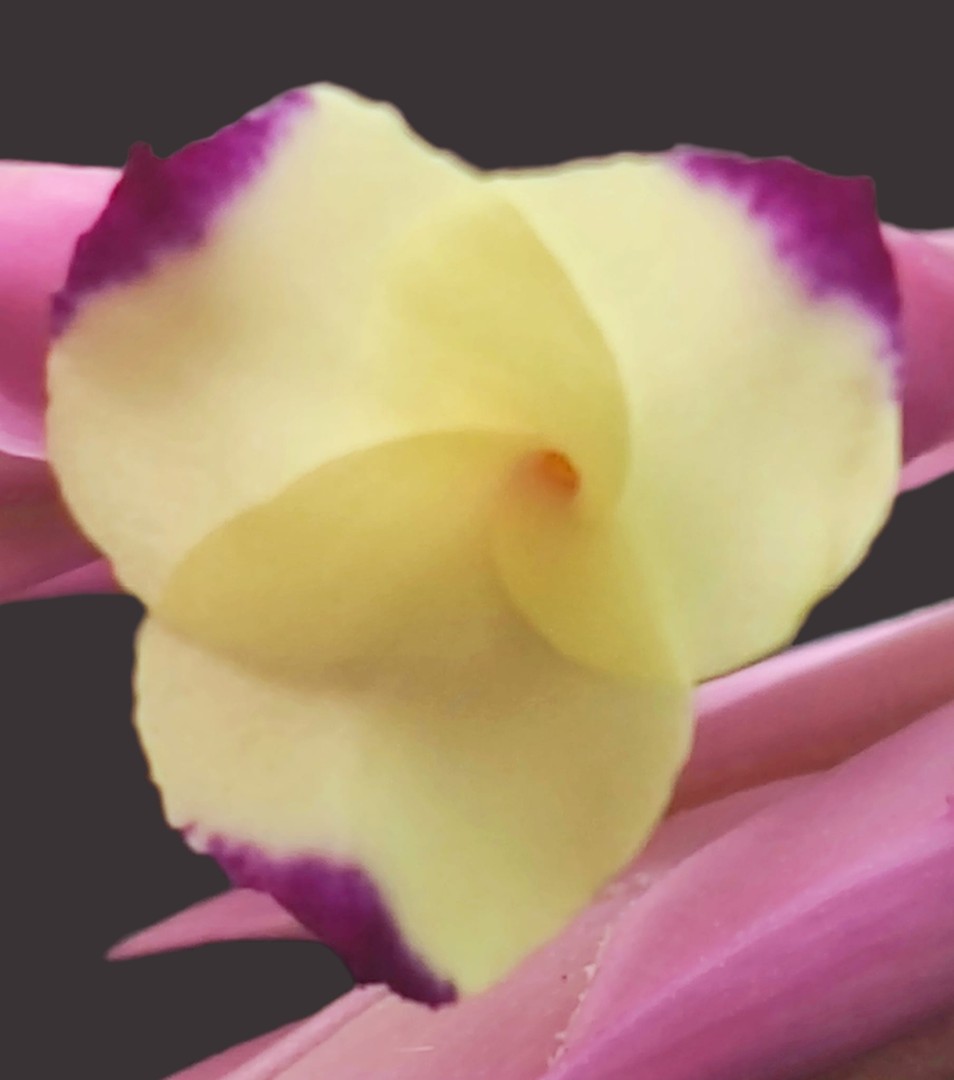
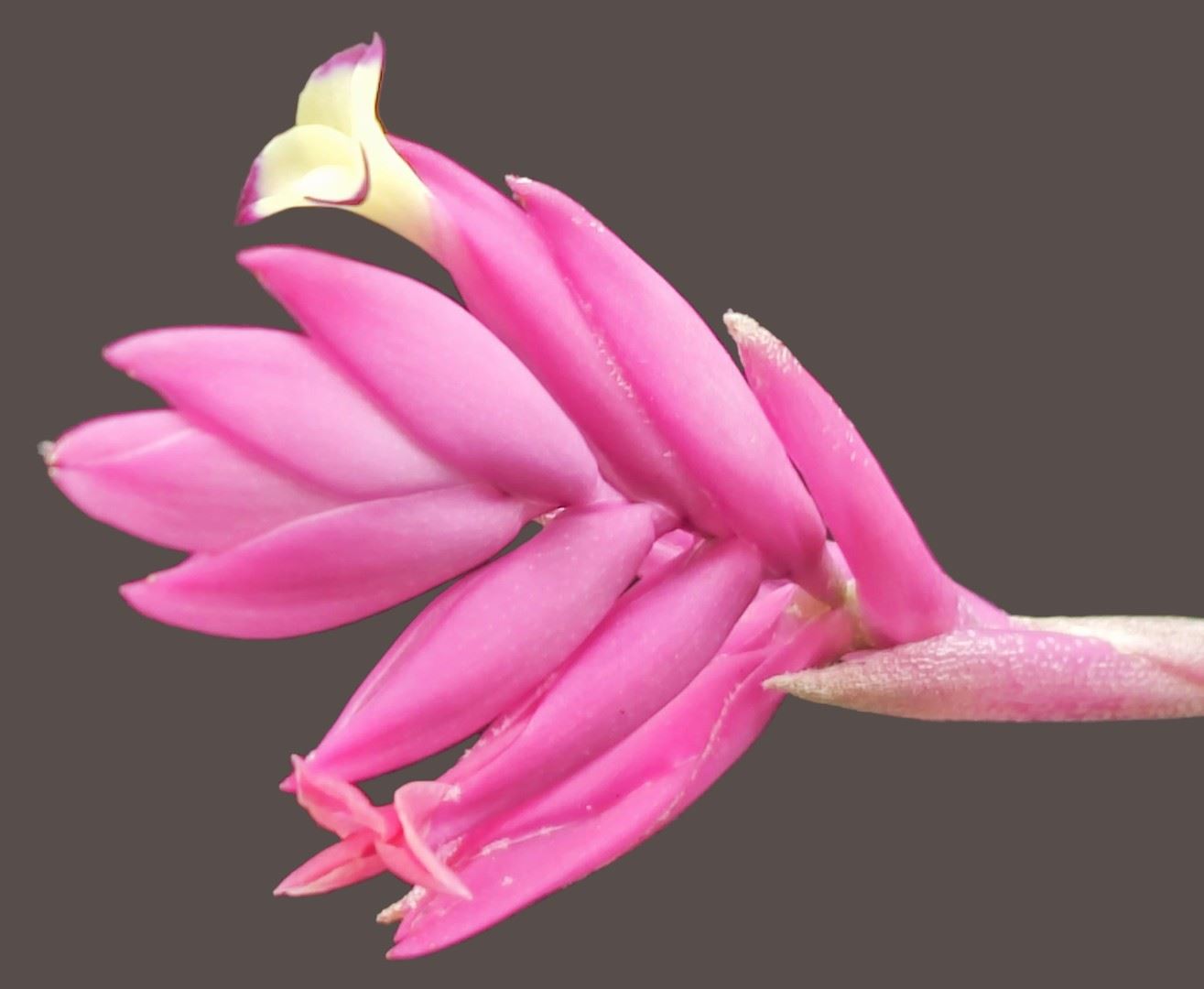
| Steven Molnar 08/22 "Two forms" |
Tillandsia cacticola L. B. Smith, Contr. U. S. Natl. Herb. 29: 534, jig. 89. 1954.
Desc from S&D p865-6
Plant stemless, flowering 15 cm and much higher.
Leaves many, spreading, 8 cm long, covered with coarse subspreading cinereous scales; Sheaths indistinct;
Blades linear-triangular, subulate-attenuate, 1 cm wide.
Scape slender, curved;
Scape-bracts imbricate, closely involute about the scape, densely lepidote, caudate at apex.
Inflorescence digitate from 3-12 spikes;
Primary bracts elliptic, acute, more than half as long as the spikes, thin, lepidote;
Spikes subsessile, broadly elliptic, strongly compressed, 3 cm long, 2 cm wide, subdensely 5-6-flowered; rhachis geniculate, slender, lepidote.
Floral bracts many times longer than the internodes but exposing most of the rhachis, elliptic, acute, to 20 mm long, exceeding the sepals, membranaceous, carinate, incurved at apex, sparsely lepidote.
Sepals lanceolate, acute, 16 mm long, very sparsely lepidote, connate posteriorly for 1 mm;
Petals yellow (with violet-blue tip), blades spreading, suborbicular, 6 mm long;
Stamens deeply included, exceeding the pistil.
Type. Sandeman 4325 (holotype K, US photo), Huancabamba, Piura, Peru, Aug 1943. DISTRIBUTION. Epiphytic on shrubs and cacti in arid formations, 325-2300 m alt, northern Peru.
PERU. PIURA: Olmos, 7 Oct 1954, Rauh P-2133 (US); Huancabamba, Aug 1956, Rauh P-303 (US). CAJAMARCA: Cochabamba, Chota, 31 Ju1 1946, Ferreyra 786 (US, USM); Yamaluc, Huambos to Cochabamba, 14 Aug 1952, Ferreyra 8467 (US, USM); San Marcos, 17 Oct 1964, Sanchez 26 (US); Hacienda La Colpa, 5 Oct 1965, Sanchez 122 (US). AMAZONAS, Bagua: El Milagro to Aramango, 25 May 1963, Lopez, Sagastegui & Collantes 4149 (TRP, US). LIBERTAD, Huamachuco: Yanazara, 25 Jun 1958, Lopez & Sagastegui 2769 (TRP, US); 16 Aug 1966, Infanta 1648 (US).
Updated 14/08/22































